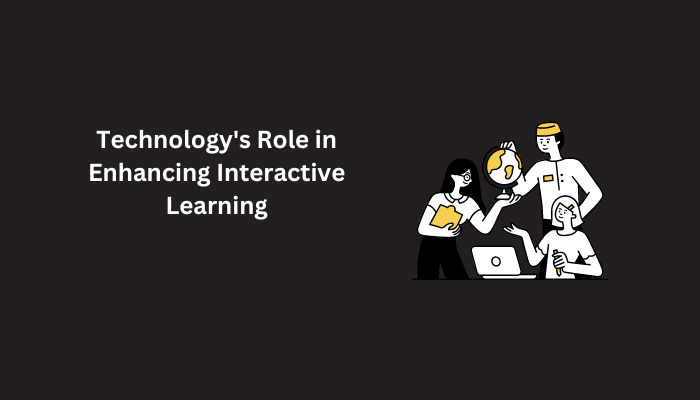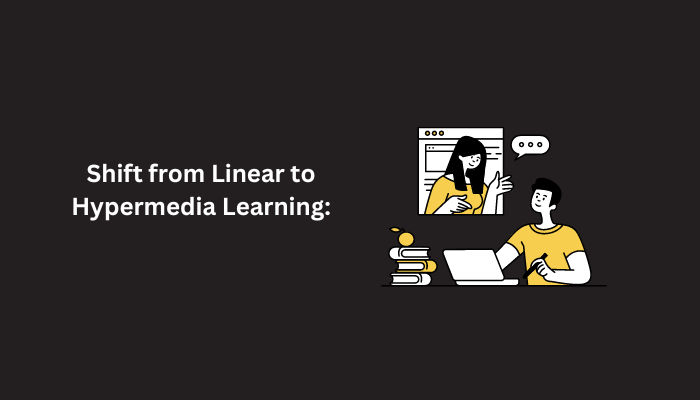Interactive learning epitomises a revolutionary educational approach driven by technology and centred on student engagement. Unlike traditional passive learning methods, interactive learning immerses students in an active, participatory educational experience, enhancing comprehension and retention of knowledge.
Let's delve into the essence of interactive learning, exploring its definition, contrasting it with traditional methods, and elucidating the significance of employing diverse teaching techniques for optimal student success.
Defining Interactive Learning:
Interactive learning represents a dynamic educational paradigm that leverages technology to foster active student engagement. Through a myriad of interactive tools and resources, students become active participants in their learning journey, empowering them to explore, inquire, and construct knowledge in meaningful ways.
This approach transcends the confines of traditional classroom settings, offering a personalized, immersive learning experience tailored to individual learning styles and preferences.
Contrasting with Traditional Methods:
In stark contrast to traditional passive learning methods characterized by rote memorization and one-way transmission of information, interactive learning emphasises active participation and collaboration.
Rather than mere recipients of knowledge, students actively engage with course material through interactive exercises, simulations, and multimedia resources, leading to deeper understanding and long-term retention of concepts.
The Significance of Teaching Techniques:
It is imperative to incorporate various teaching techniques to cater to individual preferences and optimize learning outcomes.
By employing interactive activities, group discussions, hands-on experiments, and multimedia presentations, educators can create a dynamic learning environment that stimulates curiosity, promotes critical thinking, and cultivates a lifelong love for learning.
In essence, interactive learning transcends the boundaries of traditional education, offering a transformative approach that empowers students to become active agents in their learning process.
Through technology-enabled engagement and a rich array of teaching techniques, interactive learning paves the way for a future where education is not just transmitted but experienced, absorbed, and internalized in profound and meaningful ways.
Now that we've seen how diverse teaching techniques can revolutionize the classroom experience, let's dive deeper and explore the foundational elements that make interactive learning truly stand out.
Exploring the Foundation of Interactive Learning: Core Components and Paradigms
Interactive learning embodies a dynamic shift in educational paradigms, marked by innovative approaches and transformative components that redefine the learning experience.
Let's delve into the core components and paradigms of interactive learning, unravelling the essence of its evolution and impact.
Shift From Linear To Hypermedia Learning
Traditional learning models often follow a linear progression, where information is presented sequentially, limiting the flexibility and depth of engagement. In contrast, interactive learning embraces hypermedia, a non-linear approach that integrates various multimedia elements such as text, graphics, audio, and video.
This dynamic framework enables students to navigate content freely, delve deeper into areas of interest, and engage with material in interactive and immersive ways, fostering a richer and more personalised learning experience.
Transition from Teacher as Transmitter to Facilitator:
Interactive learning heralds a fundamental transformation in the role of the educator, shifting from the traditional model of the teacher as a transmitter of knowledge to a facilitator of learning.
Rather than being the primary source of information, educators serve as guides and mentors, orchestrating collaborative learning experiences and empowering students to take ownership of their learning journey.
Through facilitation, educators cultivate critical thinking, problem-solving skills, and self-directed learning capabilities, nurturing students to become active participants in their educational endeavours.
Incorporation of Social Media, Urban Computing, and Serious Games:
Interactive learning embraces a diverse array of technological tools and platforms to enrich the learning experience and promote active engagement.
Social media platforms provide avenues for collaboration, knowledge sharing, and community building, fostering a collaborative learning environment that transcends physical boundaries.
Urban computing technologies leverage the ubiquity of smartphones and mobile devices to enhance learning experiences both inside and outside the classroom, enabling seamless access to educational resources and real-world applications.
Additionally, serious games offer immersive and interactive experiences that combine entertainment with educational content, motivating students through gamification elements and fostering a deeper understanding of complex concepts.
In essence, the core components and paradigms of interactive learning represent a seismic shift in educational methodologies, embracing technology, collaboration, and student-centred approaches to redefine the learning landscape.
By embracing hypermedia learning, transitioning to facilitative roles, and harnessing the power of emerging technologies, interactive learning paves the way for a future where education is dynamic, engaging, and transformative.
With a solid understanding of interactive learning's core components under our belt, it's time to look at practical strategies and the undeniable benefits they bring to the table.
Strategies to and Benefits of Different Interactive Learning
|
Strategies for Implementing Interactive Learning |
Description |
Benefits of Interactive Learning |
|
Enhanced Lecture with Interactive Tools |
Integrate polling apps and feedback mechanisms into lectures for real-time engagement. |
-Engages students actively during lectures - Provides immediate feedback for a better understanding |
|
Flipped Classroom Approach |
Invert traditional teaching methods by having students engage with instructional content independently outside of class, allowing in-class time for interactive discussions and activities. |
- Promotes self-paced learning - Encourages active participation in discussions and activities during class. |
|
Peer Instruction for Collaboration |
Promote collaborative learning through peer instruction, where students engage in discussions, debates, and problem-solving activities. |
- Fosters collaboration and teamwork skills - Enhances understanding through peer teaching and discussion |
|
Team-Based Learning (TBL) |
Implement team-based learning methodologies, emphasizing collaborative problem-solving and application exercises. |
- Encourages teamwork and cooperation - Provides opportunities for real-world application of knowledge |
|
Continuous Assessment and Personalized Learning |
Utilize technology for continuous assessment and personalized learning experiences tailored to individual student needs. |
- Offers personalised learning experiences - Provides immediate feedback for student progress and areas of improvement |
Challenges and Solutions in Interactive Learning
Interactive learning, while offering numerous benefits, also comes with its fair share of challenges. Addressing these challenges effectively is crucial for ensuring a seamless and productive learning experience. Here are some common challenges and potential solutions in interactive learning:
1. Addressing Technical Issues and Software Glitches:
-
One of the primary challenges in interactive learning is dealing with technical issues and software glitches that may disrupt the learning process.
-
To address this challenge, educational institutions must invest in robust IT infrastructure and provide technical support to both teachers and students.
-
Regular maintenance and updates of software and hardware can help minimize technical disruptions and ensure smooth operation during interactive learning sessions.
2. Balancing Time Preparation by Teachers for Digital Resources:
-
Another challenge faced by educators in interactive learning is the time required for preparing digital resources and materials for lessons.
-
To overcome this challenge, teachers can streamline the process of resource creation by utilizing pre-existing educational content available online.
-
Collaborating with other educators and sharing resources can also help reduce the burden on individual teachers and promote the sharing of best practices.
-
Additionally, investing in user-friendly authoring tools and platforms can simplify the process of creating interactive learning materials, allowing teachers to focus more on instructional design and content delivery rather than technical aspects.
By proactively addressing these challenges and implementing effective solutions, educational institutions can ensure that interactive learning remains engaging, efficient, and conducive to student success.
Technology's Role in Enhancing Interactive Learning

In the realm of education, technology plays a pivotal role in transforming traditional teaching methods into dynamic and engaging interactive learning experiences. Here's how technology enhances interactive learning:
1. Integration of Social Media, Blogs, and Educational Apps:
- Social media platforms, blogs, and educational apps offer innovative avenues for interactive learning by providing collaborative spaces, discussion forums, and multimedia-rich content.
- Teachers can leverage these platforms to facilitate peer-to-peer learning, share resources, and engage students in discussions beyond the confines of the classroom.
- Educational apps, specifically designed to cater to various learning objectives, and enhance student engagement through interactive quizzes, games, and simulations.
2. Use of Urban Computing Technologies such as Smartphones and PDAs:
- Urban computing technologies, including smartphones and PDAs (Personal Digital Assistants), enable ubiquitous access to educational resources and learning materials.
- With the widespread availability of mobile devices, students can engage in interactive learning anytime, anywhere, fostering a seamless integration of learning into their daily lives.
- Mobile learning applications and platforms offer personalized learning experiences tailored to individual preferences and learning styles, catering to diverse student needs and enhancing learning outcomes.
3. Leveraging Serious Games for Immersive Learning Experiences:
- Interactive simulations and gamified learning experiences offer immersive and engaging ways to reinforce learning concepts and skills.
- By incorporating game elements such as challenges, rewards, and progression systems, educators can create motivating learning environments that captivate students' attention and encourage active participation.
- Serious games simulate real-world scenarios, allowing students to apply theoretical knowledge in practical contexts, thereby enhancing problem-solving skills and critical thinking abilities.
4. Facilitating Both Synchronous and Asynchronous Content Delivery:
- Technology facilitates flexible content delivery methods, including synchronous and asynchronous learning opportunities.
- Synchronous learning, exemplified by video conferencing tools and virtual classrooms, enables real-time interaction between teachers and students, fostering collaboration and immediate feedback.
- Asynchronous learning, facilitated by learning platforms and online resources, offers self-paced learning experiences that accommodate students' diverse schedules and learning preferences.
By embracing technology and leveraging its myriad capabilities, educators can create dynamic, interactive learning environments that inspire curiosity, foster collaboration, and empower students to achieve their full potential.
We've explored how technology is currently shaping interactive learning, but what does the future hold? Let's cast our gaze forward and get a glimpse of the exciting possibilities on the horizon.
The Future of Interactive Learning
As we gaze into the horizon of education, the future of interactive learning shines brightly, promising transformative advancements in pedagogy and student engagement.
The potential impact and evolution of interactive learning methods are poised to revolutionize traditional educational paradigms, ushering in an era of innovation and accessibility.
With rapid advancements in technology and digital tools, interactive learning methodologies will continue to evolve, offering educators and learners unprecedented opportunities for collaboration, creativity, and personalized learning experiences.
At FunFox, we recognize the pivotal role of interactive learning in shaping the future of education. With a keen focus on technology integration and student-centric learning, we are committed to providing cutting-edge online tutoring services for children aged 6-12 in reading and writing.
Our innovative approach leverages interactive learning tools and engaging teaching methodologies to create immersive educational experiences that captivate young minds and foster a love for learning. Through our tailored curriculum and personalized instruction, we empower students to explore, discover, and excel in their academic journey.
Conclusion
In conclusion, interactive learning stands as a beacon of innovation and transformation in the realm of education. By embracing technology-driven engagement and student-centric approaches, interactive learning redefines traditional educational paradigms, fostering active participation, collaboration, and critical thinking skills among students.
As we reflect on the evolution of educational philosophy, it becomes evident that interactive learning is not merely a trend but a fundamental shift towards more dynamic and effective learning experiences.
The critical role of interactive learning in modern education cannot be overstated. It empowers students to become active agents in their educational journey, equipping them with the skills and knowledge needed to thrive in an increasingly complex and interconnected world.
From enhancing information retention to promoting collaboration and problem-solving, interactive learning opens doors to new possibilities and opportunities for educational excellence.
Interactive learning will continue to play a pivotal role in shaping the way we teach and learn. By embracing the principles of technology integration, collaboration, and student-centeredness, we can harness the full potential of interactive learning to unlock a brighter and more inclusive future for all learners.
Join FunFox today and discover the transformative power of personalized online tutoring in reading and writing for children aged 6-12. Together, let's empower young minds and inspire a lifelong love for learning.






















